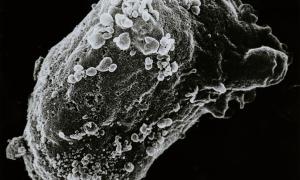People with low HIV reservoir and located in short-lived cells, an ideal scenario for eradicating the virus

IrsiCaixa is exploring why some people living with HIV and receiving antiretroviral treatment have a lower viral reservoir than others with the same conditions | The Institute has discovered that 47% of the reservoir in these individuals is found in short-lived cells, which could explain these lower levels
The main obstacle to achieving a cure for HIV is the ability of this virus to hide in a latent state inside some of the cells it infects and, in this way, establish a viral reservoir that is unalterable in the face of treatments and the immune system itself. Today, the research team at the IrsiCaixa AIDS Research Institute –a centre jointly promoted by the "la Caixa" Foundation and the Department of Health of the Generalitat de Catalunya– has published an article in the Journal of Internal Medicine in which they have characterised a profile of people living with HIV but in their case, this viral reservoir is very small. Comparing the reservoir characteristics of this profile of people with HIV with those of other people living with HIV, they have been able to confirm that their reservoir is minimal and that 47% of this latent virus resides in short-lived cells, which could explain its low quantity. This makes these people good candidates for future HIV cure strategies, as it would facilitate the elimination of this reservoir.
The progression of HIV infection can be different for each person, and depends on factors such as the immune response against the virus, the characteristics of the infection, and the time at which the individual starts treatment, among others. Throughout more than 40 years of HIV research, the scientific community has been able to detect the existence of profiles of people who manage to control the virus in an unusual way. Two years ago, the Retrovirology and Clinical Studies Group (GREC) at IrsiCaixa described for the first time a profile of people who, despite needing antiretroviral treatment to keep the virus at bay, had a much smaller than average reservoir of HIV and, in addition, maintained a healthy immune system despite the ravages that the infection causes in immune cells. "Studying this profile of response to infection is interesting not only to understand what factors help to reduce the amount of viral reservoir and to be able to apply this knowledge to the design of a cure for HIV, but also because these people are good candidates to apply cure strategies to", explains Javier Martínez-Picado, principal investigator of the GREC group at IrsiCaixa and ICREA professor.
A minimal reservoir made up of defective viruses located in short-lived cells
Two years after the identification of this profile of people, known as LoViReT (Low Viral Reservoir Treated), researchers have launched a study to better characterise these individuals. The project involves 22 LoViReT individuals –the study group– and 22 individuals with a standard HIV reservoir –the control group. Both the control and study groups are HIV-infected people on antiretroviral treatment who have had an undetectable viral load in their blood for at least three years. By analysing the total amount of HIV genome present in peripheral blood, the researchers were able to confirm that people in the LoViReT cohort have lower levels of viral reservoir compared to the control group. In addition, they found that many of the viruses are defective and, in fact, 71% of the individuals in the LoViReT group could not detect viruses capable of multiplying in their blood. "We know that the amount of HIV reservoir is five to ten times higher in lymphoid tissues, such as the rectum or lymph nodes, compared to peripheral blood, so we thought it was necessary to study, through biopsies, the amount of HIV in these tissues", says Maria Salgado, associate researcher at IrsiCaixa. "The results conclude that people in the LoViReT cohort have a minimal amount of reservoir in these tissues, with values seven times lower than those indicated by bibliographic data for people with a standard HIV reservoir", she adds.
Finally, we also looked at the distribution of the HIV reservoir in these people and found that 47% of the virus was hidden in short-lived immune system cells. These results contrast with those of people with a standard viral reservoir, which is predominantly located in longer-lived immune system cells. "Short-lived cells are easier to eliminate with antiretroviral therapy and this could explain why the reservoir levels of people in the LoViReT group are lower", says Cristina Gálvez, first author of the study and researcher at IrsiCaixa.
A candidate profile for new HIV cure strategies
Eliminating the reservoir is the first step towards an HIV cure. That's why most cure strategies initially aim to control or eliminate the virus that remains latent inside cells. "Interestingly, there is a group of people who naturally already have a smaller reservoir. Their baseline scenario favours the elimination of this viral reservoir, which makes them exceptional candidates for future HIV cure strategies", says Salgado. One such cure strategy focuses on reactivating the viruses that are hidden in the cells that make up the reservoir so that the immune system and treatments can detect and eliminate them. "For this profile of people, this strategy could be advantageous because they have less reservoir to destroy and, in addition, a large part of this reservoir is located in cells that are easily eliminated with antiretroviral treatment", concludes Martínez-Picado. The team has received a project from the US National Institutes of Health (NIH) to continue this line of research and further evaluate the characteristics of the LoViReT cohort, as well as its potential in the search for solutions against HIV.